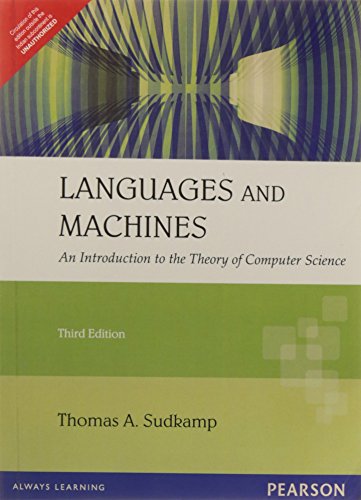

Most ebook files are in PDF format, so you can easily read them using various software such as Foxit Reader or directly on the Google Chrome browser.
Some ebook files are released by publishers in other formats such as .awz, .mobi, .epub, .fb2, etc. You may need to install specific software to read these formats on mobile/PC, such as Calibre.
Please read the tutorial at this link. https://ebooknice.com/page/post?id=faq
We offer FREE conversion to the popular formats you request; however, this may take some time. Therefore, right after payment, please email us, and we will try to provide the service as quickly as possible.
For some exceptional file formats or broken links (if any), please refrain from opening any disputes. Instead, email us first, and we will try to assist within a maximum of 6 hours.
EbookNice Team

Status:
Available0.0
0 reviews(Ebook) Languages and Machines An Introduction to the Theory of Computer Science 3rd Edition by Thomas A Sudkamp - Ebook PDF Instant Download/Delivery: 9788131714751 ,8131714756
Full download (Ebook) Languages and Machines An Introduction to the Theory of Computer Science 3rd Edition after payment

Product details:
ISBN 10: 8131714756
ISBN 13: 9788131714751
Author: Thomas A Sudkamp
(Ebook) Languages and Machines An Introduction to the Theory of Computer Science 3rd Edition Table of contents:
Chapter 1: Mathematical Preliminaries
Set Theory
Cartesian Product, Relations, and Functions
Equivalence Relations
Countable and Uncountable Sets
Diagonalization and Self‑Reference
Recursive Definitions
Mathematical Induction
Directed Graphs
Exercises
Bibliographic Notes
Chapter 2: Languages
Strings and Languages
Finite Specification of Languages
Regular Sets and Expressions
Regular Expressions and Text Searching
Exercises
Bibliographic Notes
Chapter 3: Context‑Free Grammars
Context‑Free Grammars and Languages
Examples of Grammars and Languages
Regular Grammars
Verifying Grammars
Leftmost Derivations and Ambiguity
Context‑Free Grammars and Programming Language Definition
Exercises
Bibliographic Notes
Chapter 4: Normal Forms for Context‑Free Grammars
Grammar Transformations
Elimination of Rules
Elimination of Chain Rules
Useless Symbols
Chomsky Normal Form
The CYK Algorithm
Removal of Direct Left Recursion
Greibach Normal Form
Exercises
Bibliographic Notes
Chapter 5: Finite Automata
A Finite‑State Machine
Deterministic Finite Automata
State Diagrams and Examples
Nondeterministic Finite Automata
Transitions
Removing Nondeterminism
DFA Minimization
Exercises
Bibliographic Notes
Chapter 6: Properties of Regular Languages
Finite‑State Acceptance of Regular Languages
Expression Graphs
Regular Grammars and Finite Automata
Closure Properties of Regular Languages
A Nonregular Language
The Pumping Lemma for Regular Languages
The Myhill‑Nerode Theorem
Exercises
Bibliographic Notes
Chapter 7: Pushdown Automata and Context‑Free Languages
Pushdown Automata
Variations on the PDA Theme
Acceptance of Context‑Free Languages
The Pumping Lemma for Context‑Free Languages
Closure Properties of Context‑Free Languages
Exercises
Bibliographic Notes
Chapter 8: Turing Machines
The Standard Turing Machine
Turing Machines as Language Acceptors
Alternative Acceptance Criteria
Multitrack Machines
Two‑Way Tape Machines
Multitape Machines
Nondeterministic Turing Machines
Turing Machines as Language Enumerators
Exercises
Bibliographic Notes
Chapter 9: Turing Computable Functions
Computation of Functions
Numeric Computation
Sequential Operation of Turing Machines
Composition of Functions
Uncomputable Functions
Toward a Programming Language
Exercises
Bibliographic Notes
Chapter 10: The Chomsky Hierarchy
Unrestricted Grammars
Context‑Sensitive Grammars
Linear‑Bounded Automata
The Chomsky Hierarchy
Exercises
Bibliographic Notes
Chapter 11: Decision Problems and the Church‑Turing Thesis
Representation of Decision Problems
Decision Problems and Recursive Languages
Problem Reduction
The Church‑Turing Thesis
A Universal Turing Machine
Exercises
Bibliographic Notes
Chapter 12: Undecidability
The Halting Problem for Turing Machines
Problem Reduction and Undecidability
Additional Halting Problem Reductions
Rice’s Theorem
An Unsolvable Word Problem
The Post Correspondence Problem
Undecidable Problems in Context‑Free Grammars
Exercises
Bibliographic Notes
Chapter 13: Mu‑Recursive Functions
Primitive Recursive Functions
Some Primitive Recursive Functions
Bounded Operators
Division Functions
Gödel Numbering and Course‑of‑Values Recursion
Computable Partial Functions
Turing Computability and Mu‑Recursive Functions
The Church‑Turing Thesis Revisited
Exercises
Bibliographic Notes
Chapter 14: Time Complexity
Measurement of Complexity
Rates of Growth
Time Complexity of a Turing Machine
Complexity and Turing Machine Variations
Linear Speedup
Properties of Time Complexity of Languages
Simulation of Computer Computations
Exercises
Bibliographic Notes
Chapter 15: P, NP, and Cook’s Theorem
Time Complexity of Nondeterministic Turing Machines
The Classes P and NP
Problem Representation and Complexity
Decision Problems and Complexity Classes
The Hamiltonian Circuit Problem
Polynomial‑Time Reduction
P = NP?
The Satisfiability Problem
Complexity Class Relations
Exercises
Bibliographic Notes
Chapter 16: NP‑Complete Problems
Reduction and NP‑Complete Problems
The 3‑Satisfiability Problem
Reductions from 3‑Satisfiability
Reduction and Subproblems
Optimization Problems
Approximation Algorithms
Approximation Schemes
Exercises
Bibliographic Notes
Chapter 17: Additional Complexity Classes
Derivative Complexity Classes
Space Complexity
Relations between Space and Time Complexity
P‑Space, NP‑Space, and Savitch’s Theorem
P‑Space Completeness
An Intractable Problem
Exercises
Bibliographic Notes
Chapter 18: Parsing: An Introduction
The Graph of a Grammar
A Top‑Down Parser
Reductions and Bottom‑Up Parsing
A Bottom‑Up Parser
Parsing and Compiling
Exercises
Bibliographic Notes
Chapter 19: LL(k) Grammars
Lookahead in Context‑Free Grammars
FIRST, FOLLOW, and Lookahead Sets
Strong LL(k) Grammars
Construction of FIRSTₖ Sets
Construction of FOLLOWₖ Sets
A Strong LL(1) Grammar
A Strong LL(k) Parser
LL(k) Grammars
Exercises
Bibliographic Notes
Chapter 20: LR(k) Grammars
LR(0) Contexts
An LR(0) Parser
The LR(0) Machine
Acceptance by the LR(0) Machine
LR(1) Grammars
Exercises
Bibliographic Notes
People also search for (Ebook) Languages and Machines An Introduction to the Theory of Computer Science 3rd Edition:
what are the 5 theories of language development
4 theories of language development
3 theories of language mastery
3 major theories of language development
3 theories of language acquisition
Tags: Thomas A Sudkamp, Machines, Theory, Computer Science